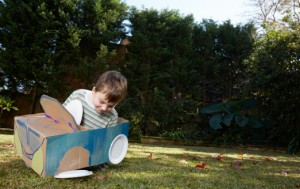 While visiting family during the holidays, we took the kids to a place called Discovery Place KIDS, a sort of play museum set up with all kinds of things for children to explore: a play grocery store where little shoppers can fill a shopping cart with food and then ring up their items at a cash register; a pretend restaurant where kids can cook and serve food; a car body shop where curious little mechanics can change tires and peek under the car.
While visiting family during the holidays, we took the kids to a place called Discovery Place KIDS, a sort of play museum set up with all kinds of things for children to explore: a play grocery store where little shoppers can fill a shopping cart with food and then ring up their items at a cash register; a pretend restaurant where kids can cook and serve food; a car body shop where curious little mechanics can change tires and peek under the car.
My dad commented, “It takes a really fertile mind to design a place like this. To really know what kids will be interested in. I look at some of this stuff and think, ‘That’s stupid.’ But then I watch all these kids playing and they are really into it!”
I found that comment interesting, thinking, “Maybe I have a ‘fertile mind’ because I think this place is awesome. I look around and think how much fun it would be to design this type of place for kids.”
What adults see as mundane, tedious, or even aggravating, kids tend to see as fun and intriguing. The vacuum tube at the bank drive-through, the security checkpoint at the airport, and the flashing lights on a fire truck are some of the many simple things children are often fascinated by. Think about it: What kid doesn’t want to push the elevator button or play with Tupperware?
We sometimes take for granted the various tasks we go about performing during our day and the different encounters we have in our lives, but all of these simple moments provide teaching opportunities for kids. Their minds are like sponges, absorbing everything they witness around them. Every day and every interaction provides opportunities to talk to and teach children. By using these ordinary experiences to talk to your kids about what is going on, how things work, and why we do the things we do, you are helping to inspire a wise and curious mind.
From early on, I began using the time spent in checkout lines to talk to my now-2-year-old about the concept of buying and paying for things. A few months ago, I watched her play pretend ice cream shop with her grandma, instructing her to hand over her “credit card” so she could “swipe it.” She then told her to “sign the receipt.” It’s always interesting to see her incorporate the things we’ve talked about into her play.
There’s something irritating yet fascinating about the way kids open a new gift, only to be more interested in the box it came in. Kids are interested in learning about the grown-up world around them and are sometimes more attracted to the simple objects we take for granted rather than the flashy, singing toys we think will keep them busy for hours. As I’m sitting here writing, my 8-month-old is ignoring the pile of toys I surrounded him with and instead trying to reach for the TV’s remote control.
By being aware of children’s curious minds and understanding that they learn through play, we can find ways to enrich their play experience, inspire imagination, and develop their creativity.
By being aware of children’s curious minds and understanding that they learn through play, we can find ways to enrich their play experience, inspire imagination, and develop their creativity. I love finding clever things to do with items you would otherwise discard. Pinterest has all kinds of creative ideas, like making animals and mermaids out of toilet paper rolls, adorable art projects out of free paint swatches, and clever travel games out of Altoid boxes. I now give my daughter the old hotel keys or used-up store credits I’m about to toss. She gets very excited to have her own “credit card.”
The other night, we made robot masks from the windows of empty pasta boxes. It took all of five seconds to rip the boxes apart; they kept the kids entertained while I finished cooking dinner. Another favorite activity of my daughter’s is making “imagination boxes.” Whenever a new delivery from Amazon shows up, I give her the box, some stickers, and crayons and she spends hours making cars, airplanes, and rocket ships.
When children play, discover, and create, they develop gross motor skills, fine-tune hand-eye coordination, learn to solve problems, acquire abstract and critical thinking skills, and develop language and social skills. Further, by learning about everyday tasks and incorporating them into play, children develop a sense of independence and self-confidence.
For children, play is hard work and they love to be hard, busy workers. When we recognize their infinite curiosity, encourage them to explore, and treat simple, everyday moments as opportunities to learn, we give our children the chance to develop to their fullest potential.
© Copyright 2016 GoodTherapy.org. All rights reserved. Permission to publish granted by Megan MacCutcheon, LPC, Self-Esteem Topic Expert Contributor
The preceding article was solely written by the author named above. Any views and opinions expressed are not necessarily shared by GoodTherapy.org. Questions or concerns about the preceding article can be directed to the author or posted as a comment below.

 Inspiring Your Own Joy: The Lessons of Pixar’s 'Inside Out'
Inspiring Your Own Joy: The Lessons of Pixar’s 'Inside Out' Second Time Around: The Transition from One to Two Children
Second Time Around: The Transition from One to Two Children Want to Help Your Kids? You Can Start by Not Helping Them
Want to Help Your Kids? You Can Start by Not Helping Them